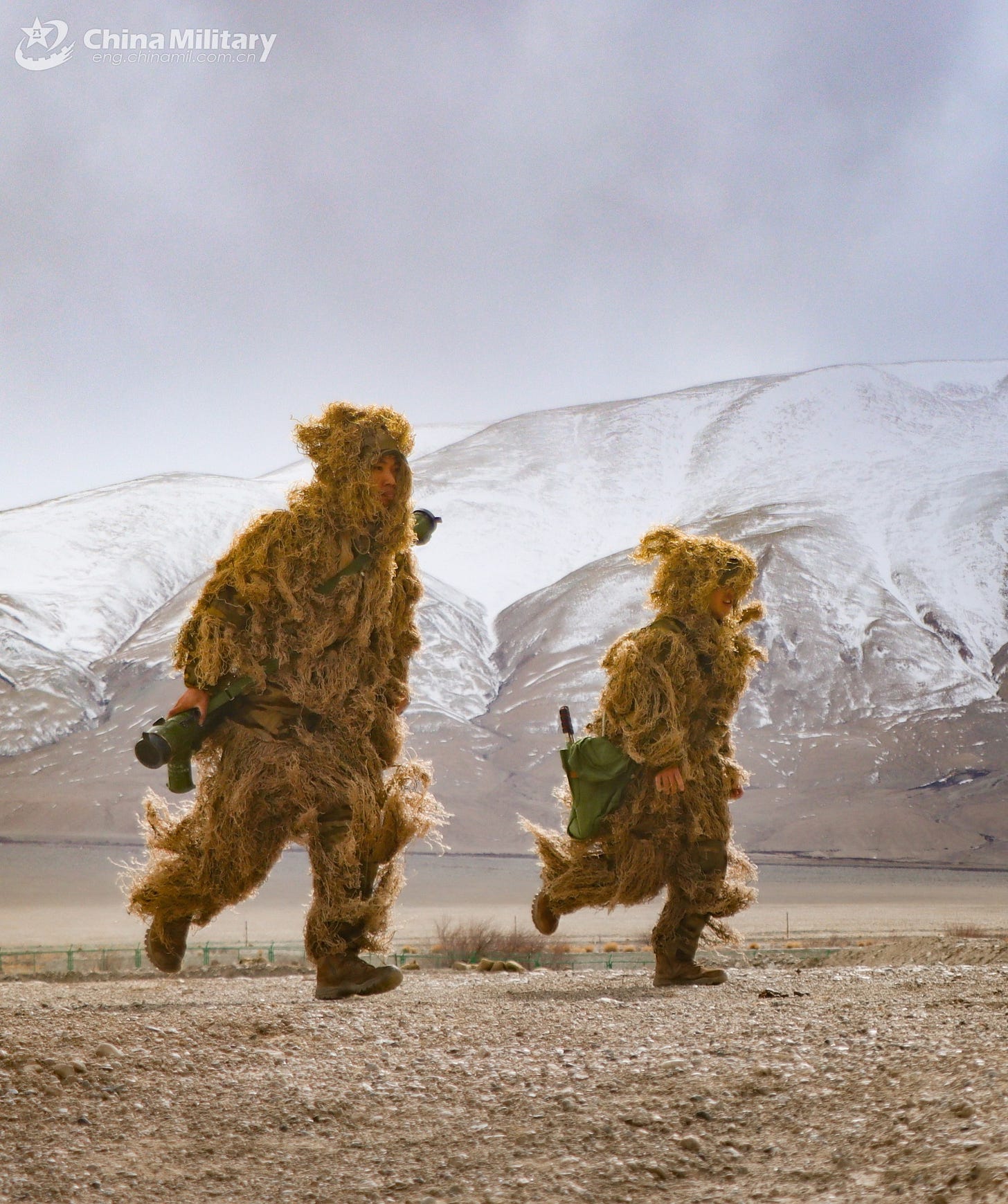Left, Right, Left!
Long-ish Coverage of the September 3 Military Parade Marking the '80th Anniversary of China's Victory in the War of Resistance against Japanese Aggression'.
The much-awaited September 3 parade in Tiananmen Square happened today (starting 9 A.M. Beijing time), and a nighttime gala event on the theme ‘Justice will Prevail’ was held (starting 8 P.M. Beijing time).
Before I get to a detailed breakdown, here are my three key takeaways from everything that was displayed at the morning event:
The focus on unmanned combat preparedness is gaining great traction. For the parade to focus on display of robotic “wolves” and show their use in human-robot combined gunfights, and further put on demonstration a formation of China’s best drone systems, was purely focused on depicting how the goal is to create a quality-focused PLA, reduce casualties as drones undertake ISR tasks and relay data before human strikes, and train the force in combat victory in the new present and future of warfare.
The shift from solid- to liquid-fuelled thrust in the DF-5C unveiled today, is most fascinating, given that the transition to solid fuel ICBMs/ ICNMs is hard-won. But the guarantees from Chinese military experts that the new features of the variant reduce prep time because of its three-part distinct transport mechanism, create a space to deliberate the implications of the 5C’s rapid-strike capabilities and range. Not to mention, the guarantees are backed by official statements on the 5C always being on “full alert” to “use force to stabilise the world.”
The informatisation of tanks was evident. There has been focus in the PLA on creating light/ medium weight 4th generation tanks that would ideally be susceptible to quick destruction through drone or missile strikes. But the goal of the parade’s land formations was to show that such vulnerabilities are being dealt with by integrating “active protection” systems like electro-optical sensors on tanks – which effectively amounts to prevention over cure.
Xi’s Speech
To start off, let’s assess Chinese President Xi Jinping’s remarks at the Parade itself. His speech was brief, and there were only a few points of note in his instructions to the people, and the military & security apparatus:
First, there was a lot of emphasis laid on the Chinese people’s “indomitable spirit,” and their resilience and ability to fight and win wars. It sounded like stage-setting for the sombre view of the world he presented. He also stated that China is a “self-reliant and strong” nation whose people should rise in unison for “national survival, for national rejuvenation, and for the justice of humanity.” He also called on “people of all ethnic groups across the country must uphold Marxism-Leninism, Mao Zedong Thought, Deng Xiaoping Theory, the important thought of the ‘Three Represents’, the Scientific Outlook on Development, and fully implement the [Xi Jinping] Thought on Socialism with Chinese Characteristics for a New Era.”
Next, he shared said view of the world. He argued, that today, “humanity is again confronted with choices: peace or war, dialogue or confrontation, win-win cooperation or zero-sum rivalry.” In this light, he expressed the belief that Chinese people firmly stand on the right side of history, i.e. on the side of human civilisation and progress.
Speaking of progress and prosperity, he potentially took a jab at countries and governments that find China’s rise anything but peaceful. He said, “History warns us: the destiny of humanity is shared. Only when nations and peoples treat each other as equals, live in harmony, and watch out for and help one another, can we safeguard common security, eliminate the roots of war, and prevent the recurrence of historical tragedies.” Though, him envisioning the world as having a shared future and common destiny, almost styled in the image of the classic Hedley Bull-inspired international society, is not new, and neither is his concept of “common & indivisible security” – which inevitably ties the security of China with the security of other countries.
He concluded with a bold slogan, which speaks meaning in and of itself:
“The great rejuvenation of the Chinese nation is unstoppable! The noble cause of peace and development for humanity will surely triumph!”
Those are largely the interesting bits from his remarks. Now, let’s assess the parade itself, and contributors to the process. The parade was divided into two stages, lasting a total of 70 minutes: the ceremonial inspection and the march-past, featuring a total of 45 formations/ echelons (units).
Formations and Equipment
Contingents from three new support forces – the Military Aerospace Force (MAF/ ASF), the Cyberspace Force (CSF), and the Information Support Force (ISF) – made their parade debuts, with their new flags. Land Combat Groups (陆上作战群), Maritime Battle Groups (海上作战群), Air Defence and Anti-Missile Groups (防空反导群), Information Operations Groups (信息作战群), Unmanned Combat Groups (无人作战群), other air-borne echelons (空中梯队), and Strategic Strike (战略打击群) & Logistics Support Groups (后装保障群) all demonstrated capabilities through formations and weapons displays. Let’s assess few of these one-by-one.
Land Combat
22 combat vehicles of the ground assault formation, arranged in an “arrow” shape, passed through Tiananmen Square. They were colloquially referred to as the “Kings of Land Warfare” in Xinhuanet’s coverage.
As the new generation of armoured equipment for the Army’s ground assault forces, the reviewed Type 99B tanks, Type 100 tanks, and Type 100 support vehicles, meant to demonstrate rapid manoeuvres and ability to break through lines of defence.
The Type 99B tank, building upon the foundation of the Type 99A tank through technological integration and functional upgrades, has aimed to enhance capabilities in integrated joint operations under informatised conditions, multi-target firepower strikes, manoeuvring in complex terrains, and sustaining crew combat effectiveness under adverse weather conditions.
The Type 100 tank and Type 100 support vehicle are capable of carrying out missions such as long-range rapid deployment, seizure and control of operational objectives, deep tactical assaults, urban offensive and defensive operations, and joint firepower coordination.
Military commentators in China observed a few interesting things about the tanks and support vehicles: a) Multiple types of electro-optical sensors are installed on the turrets and vehicle bodies, along with remote-controlled weapon stations and active protection systems. b) In addition to the sensors, the Type 100 tanks and armoured vehicles use active protection interceptor rounds and unmanned weapon stations to defend against incoming anti-tank munitions and drones (a highly important lesson the PLA must be drawing from the Russia-Ukraine war).
Because the tanks displayed operate on “4th gen” design philosophy, they represent the move away from the traditional ‘armor versus shell’ dynamic to an integrated model combining information systems and firepower – ‘information-fire integration’ – the firepower of the new-generation tanks and armoured vehicles is elevated, thanks to the advantages of advanced information systems. 3rd generation tanks relied primarily on increasing armour thickness, using composite armour, or reactive armour to enhance passive defence capabilities. However, this approach has been shown to lag behind the evolving demands of the modern battlefield.
Anyway, this formation was primarily drawn from a composite brigade of the PLA Ground Forces’ 82nd Group Army (Baoding, Hebei-based, affiliated with the Central Theater Command). This unit was the PLA’s first motorised force, first mechanised force, and first digitised force.
An amphibious assault formation also passed through Tiananmen Square.
The unveiled amphibious wheeled armored infantry vehicles, amphibious wheeled armored assault vehicles, and amphibious wheeled self-propelled howitzers, are all newly developed domestic equipment. They serve as the main combat platforms of the Marine Corps in carrying out amphibious landing operations, rapid seizure of key positions in depth, and emergency quick-reaction missions. Their goal is to achieve strong amphibious manoeuvrability, adaptability to complex environments, communication and coordination capabilities, and enhanced firepower and protection.
This formation was drawn from the PLA Marine Corps. The Marine Corps is an “elite force” focused on rapid response and capable of operations across all domains. It is also an amphibious strike force tasked with safeguarding China’s overseas interests.

Next was the airborne assault formation. They were colloquially referred to as the PLAGF’s “Airborne Blade” in Xinhuanet’s coverage.
There were 3 new domestically developed new-generation tracked airborne combat vehicles added to the family. The reviewed equipment included the new tracked multi-purpose transport vehicle, new tracked airborne fighting vehicle, and the new tracked self-propelled howitzer.
These three types of equipment are compatible with large military transport aircraft for airlift and airdrop, capable of long-range aerial delivery and heavy mechanised support. They serve as the PLA’s “airborne blade” for rapid reaction and deep strike operations.
This formation was primarily drawn from an unspecified unit of the PLA Air Force’s Airborne Corps.
Finally, a long-range artillery formation was reviewed under land combat groups. Guided by two lead vehicles, 16 Type 191 long-range modular (box-type) rocket launchers passed through Tiananmen Square.
The two variants of the Type 191 long-range modular rocket launcher that made their debut are characterised by long range, high precision, rapid response, wide firepower coverage, and the ability to combine point and area strikes. In particular, the modular ammunition reload system has the potential to significantly shorten combat preparation time.
Integrating both operational-level strikes and tactical support, they can potentially conduct long-range suppression to attack the enemy and precision strikes to break enemy defences.
The long-range artillery formation was spearheaded by a brigade of the PLA Army’s 76th Group Army (Qinghai-based, affiliated with the Western Theater Command). This is a relatively new Army unit – a product of the reforms.

Maritime Battle
First was the shipborne air defence weapon formation, composed of 2 guidance vehicles and 16 transport vehicles. It was colloquially referred to as the PLA’s “Armour” – a Sky and Sea Shield.
The four types of equipment reviewed form a layered and multi-dimensional air defence system. There was the HQ-9C missile, primarily responsible for medium-range area air defence and anti-missile operations for surface ship formations. It also has the capability to intercept incoming anti-ship missiles.
Then there was the HQ-16C missile, which also undertakes medium-range area air defence and anti-missile tasks for surface ship formations and can intercept incoming anti-ship missiles.
Third was the HQ-10A missile is mainly used to intercept incoming anti-ship missiles; laser weapons possess the advantages of precise destruction and sustained strikes, and can operate in coordination with other air defense systems to enhance overall defensive capabilities.
The HQs 9 and 16 have obviously gained a lot of traction post the use of their export variants by Pakistan in its Anti-Air campaign against India during the May 2025 skirmishes. Anyway, these were naval variants organised under the leadership of an unspecified naval base (probably from Qingdao or Yulin, bases respectively affiliated with the Northern and Southern Theater Commands).
Next came the anti-ship missile formation, composed of 2 guidance vehicles and 16 transport vehicles. The news coverage on this formation said: “Eagles Unleashed, Dominating Sea and Sky! The YJ-15, YJ-19, YJ-17, and YJ-20 Missiles Make Their Debut.”
The formation comprised of YJ-15 (‘Eagle Strike’) missiles and YJ-19, YJ-17, and YJ-20 hypersonic missiles. These four types of anti-ship missiles can be deployed on carrier-based aircraft, surface ships, submarines, and other platforms. They have long range, high speed, and powerful destructive capability, making them “sharp weapons” for striking enemies at sea.
The latest YJ-21 was not on display, and its KD-21 land-attack variant was also missing. The YJ-19 has been sparking interest since its images were leaked during parade rehearsals because of its likely deployment of a scramjet engine that uses an air inlet during high-speed cruise. The air is mixed with fuel to provide thrust.
The YJ missile series forms a multi-dimensional anti-ship system, attempting to enhance the PLA Navy’s long-range, rapid strike capability. They serve as a “strategic hammer,” as the Chinese argue, for defending maritime rights and contesting sea control.
Finally, there was the Underwater Weapons Formation.
The four types of equipment reviewed have autonomous detection and multidimensional strike capabilities. The light torpedo is a new-generation lightweight anti-submarine torpedo; the rocket-assisted torpedo is a rocket-propelled anti-submarine torpedo; the heavy torpedo is a submarine-launched guided torpedo.
All three torpedoes are independently developed in China and can reportedly strike surface ships and destroy underwater targets. The newly unveiled special-purpose naval mine can also independently identify and attack targets, purportedly serving as a surprise weapon.
In addition, displayed were AQA-010 and AQS-003A, which respectively are military designators for sonobuoy recorders and potentially China’s latest towed sonar for submarine detection.
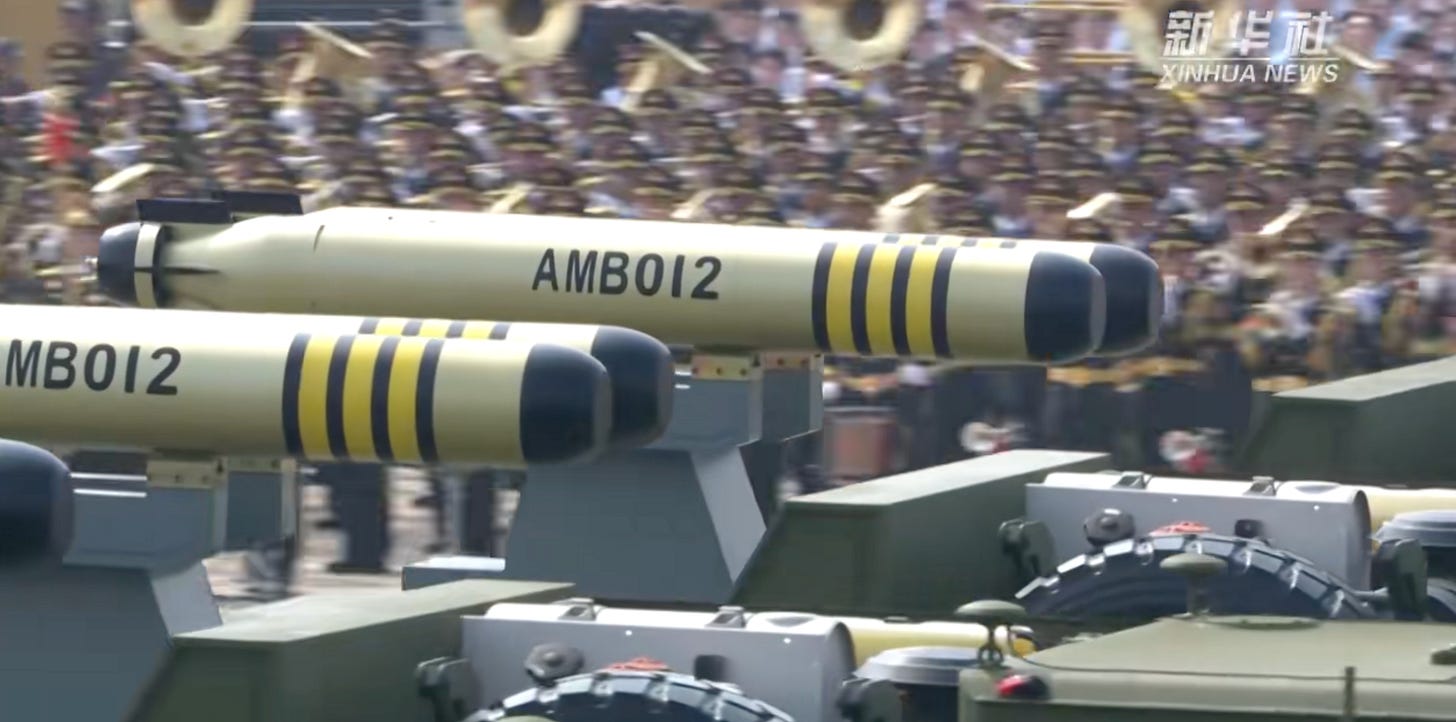
FYI: torpedoes are divided into two types – light and heavy. In addition, the rocket-assisted torpedoes are new tech, in that they mount a rocket booster onto a light torpedo as its warhead. Rocket-assisted torpedoes are mainly used to attack nuclear submarines underwater. Today, nuclear submarines travel very fast underwater, often exceeding 50 kilometres per hour, which makes it difficult for traditional torpedoes to catch up. Rocket-assisted torpedoes can be launched rapidly once a submarine is detected, with a maximum range typically reaching dozens of kilometres. After flying through the air to the designated location, the rocket-assisted torpedo re-enters the water to strike the nuclear submarine. This is why rocket-assisted torpedoes are often vividly described as ‘anti-submarine missiles’.
Light torpedoes are mainly suited for naval battles in near-shore, shallow-water areas. Because the water is relatively shallow near the Chinese coastline, it is unsuitable for heavy torpedo operations. Thus, light torpedoes have been developed for shallow-sea warfare, usually carrying out strike missions in waters 50–100 meters deep.
By contrast, heavy torpedoes are noticeably larger in size and weight compared to light torpedoes. Hence, their goal is to achieve a more extended range and carry more powerful warheads. They are mainly deployed by PLA surface vessels or submarines to attack enemy medium- and large-sized surface ships.
Air-Defence and Anti-Missile Groups
An early warning and detection formation also passed through Tiananmen Square.
The four types of equipment reviewed are all domestically produced next-generation highly mobile radars, featuring wide detection ranges, expanded operational functions, and stronger mobility. They are networked in coordination across long and short ranges, with advanced technical systems and diverse detection modes, capable of tracking stealth aircraft, ballistic missiles, and other targets.
They serve, as colloquially called, as the “thousand-mile eyes” guarding the nation’s aerospace security (a term often associated with radar units).
The early warning and detection formation was organised under the leadership of a unit of the Air Force’s radar troops.
Next, the air defence formation that passed through Tiananmen Square unveiled 6 interesting types of equipment.
Weapons included the HQ-20, HQ-19, and HQ-29, which are entirely domestically designed and produced. They are capable of multi-layer, multi-stage missile interception, primarily used to counter helicopters, aircraft, missiles, and other targets. They provide long-, medium-, and short-range air defence, remain ready to respond to aerospace threats at all times, and form a solid shield for air defence.
The air defence formation was drawn from a unit of the Air Force’s surface-to-air missile (SAM) troops. Not related to the parade, but below is an image from a unit of the PLAAF SAM troops training to seek camouflage while using Man-Portable Air Defence Systems (MANPADS), during an exercise in March 2025:
Finally, the counter-unmanned aerial vehicle (UAV) formation passed through Tiananmen Square to project China’s progress in building anti-air defence capabilities.
This formation featured systematically integrated anti-drone gun systems, high-energy laser weapons, and high-power microwave weapons. These weapons can intercept drones, loitering munition, and other targets. They can achieve both soft-kill (active protection - preemptive jamming and spoofing, etc.) and hard-kill (direct attack on drones) effects, forming a powerful “iron triangle” for countering UAV threats.
The counter-UAV formation was jointly organised by a combined-arms brigade of the PLAA and a surface-to-air missile brigade of the PLAAF.

Information Operations Groups
“Forging Cyber Warriors, Winning the Invisible Battlefield…” – that is how the appearance of the nascent Cyberspace Forces (CSF) was covered during their formation’s pass through Tiananmen Square for the first time in a Chinese military parade.
The 4 types of equipment displayed by CSF units were meant to demonstrate integrated command and control, reconnaissance and sensing, and cyber-electronic confrontation.
What is interesting about the Armoured Personnel Vehicles (APCs) aboard which the equipment were displayed, was their numbering. I have not seen ‘XZ-’ series number of APCs or Infantry Fighting Vehicles (IFVs) being used by the PLA before. But please correct me if I am wrong in the comments!

A still from Xinhuanet’s video coverage of CSF, ISF, and Electronic Warfare Formation. | Source Electronic Warfare Formation. An electronic warfare formation passed through Tiananmen Square, and the 5 core pieces of electronic warfare equipment reviewed are reportedly capable of all-frequency reconnaissance, control and precision suppression. They can also defend against aerospace threats and disrupt networks and communications.
China’s armed forces independently developed all of these systems and constitute the main operational electronic warfare equipment currently in service. They’ve been referred to as the “electromagnetic sword” for “seizing battlefield initiative.”
The electronic warfare formation was assembled from units of a MAF/ ASF base and a unit of the Northern Theater Command Ground Forces.
Finally, there was the crucial Information Support Force (ISF) formation.
The ISF’s equipment display included battlefield network-cloud-equipped vehicles, digital intelligence empowerment* vehicles, space-ground networking vehicles, and information integration vehicles, all capable of rapidly building new network-information systems to strongly support joint operations.
*To understand at least the conceptual boundaries of “digital intelligence empowerment,” one can refer to this Qiushi magazine article. It argues in the context of China’s industrial manufacturing sector:
According to Zhang Guolong, Senior Director of Final Assembly Technology at the Engineering and Technology Department of China FAW, since its completion and start of production in 2021, the Hongqi Prosperity Plant has been operating at full capacity, with an average of about 1,000 vehicles rolling off the production line each day. “To meet the needs of Hongqi’s brand expansion and new product launches, the Hongqi Prosperity Plant has built an intelligent manufacturing model that integrates automation systems with information systems vertically through the industrial internet, while also achieving cross-system horizontal integration. This model enables equipment to self-diagnose faults, production control to self-adapt, quality management to self-learn, and energy management to self-decide,” he said.
Essentially, it is the holistic incorporation of ML-enabled/ informatised technologies with any process to achieve as much autonomy as possible, with only expert/ professional human intervention required when necessary.
Unmanned Combat
The interesting formation to see on this front was the parade of the Airborne Unmanned Combat team. The formation featured new types of integrated reconnaissance-strike UAVs, loyal wingman drones, and shipborne unmanned helicopters. These systems are designed to launch covert strikes, provide wide-area coverage, and conduct autonomous coordination. The 5 categories and 7 models of equipment on display are all independently developed in China. They possess both land-based and shipborne operational capabilities, and are to be used to carry out a wide range of missions including battlefield reconnaissance, surveillance, and precision strike.
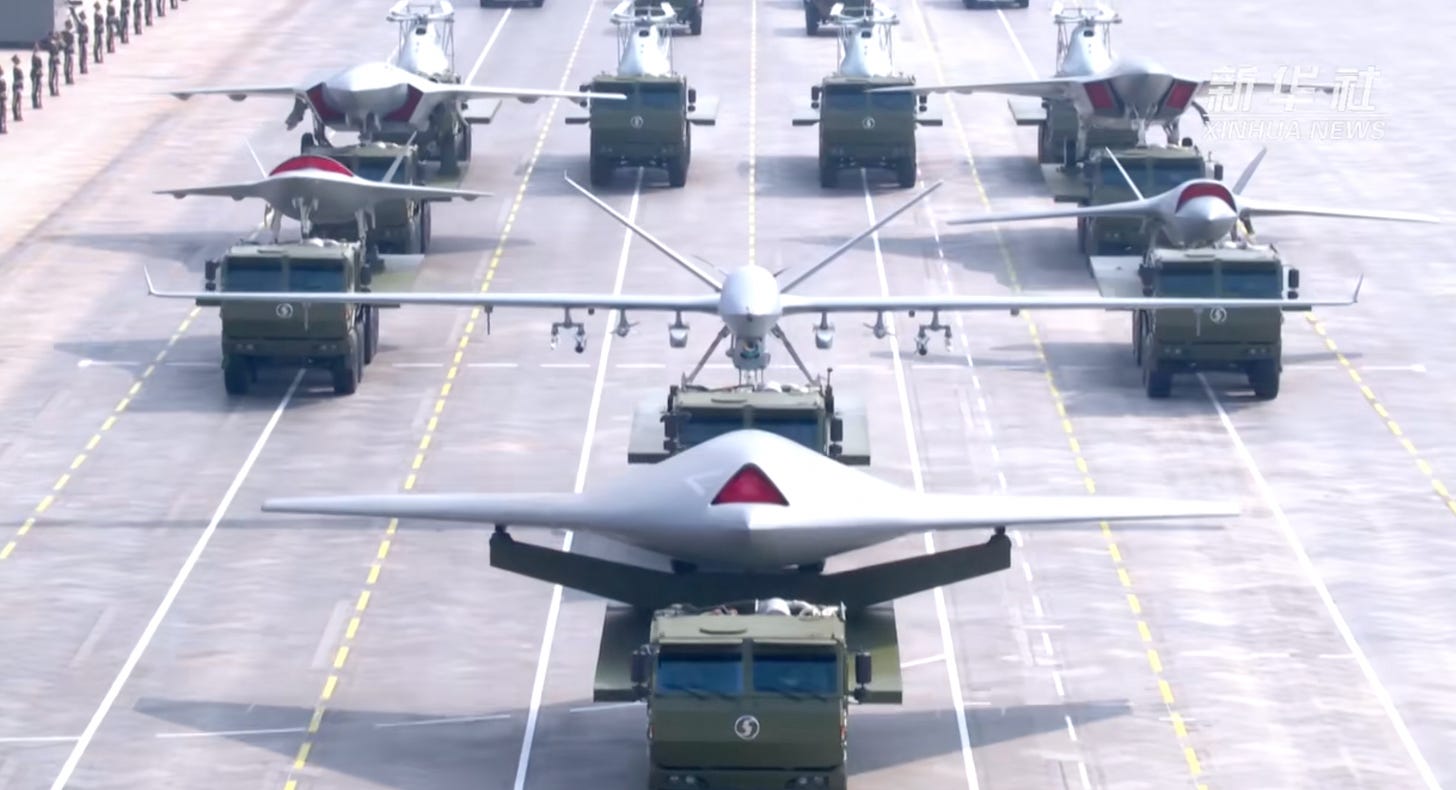
Which systems were on display? And what was the overall presentation of China’s unmanned combat doctrine like? Four main drones were on display during the unmanned combat group’s formation:
FH-97 “Loyal Wingman”: A stealth combat drone considered China’s first combat-ready “wingman” platform, designed for coordinated missions with crewed aircraft, with attack, reconnaissance, and electronic jamming capabilities.
Wing Loong-1E: Debuted as a new combat drone with capabilities intended to rival modern UAVs, including those from the US.
GJ-11 “Sharp Sword”: Stealth attack UAV, its split rudders often compared to US B-2 style bombers; primarily for deep strike, reconnaissance, and electronic warfare missions.
AJX002 & HSU001 Underwater Drones: These large, torpedo-shaped submarine drones made a high-profile appearance, with the AJX002 being publicly seen for the first time and described as a major technological advance for naval operations.
For the PLA, loyal wingmen drones have become a major source of discussion in recent years and are widely regarded as an essential component of future unmanned combat systems. According to Chinese military commentators, loyal wingmen can fly in close formation with manned fighters, executing air-superiority missions, air-defence suppression, and aerial escort. They address problems such as limited fleet size and aging aircraft, while building new manned-unmanned teaming concepts. Functioning as sensors, weapons carriers, and intelligent assistants, these drones extend pilots’ sensing and strike range. At the same time, when employed at scale in swarms, each drone can act as an intelligent node within the wider air combat system – collecting local battlefield information, filtering and fusing it, and contributing to an overall operational picture that assists pilots in decision-making. This frees pilots from the most dangerous and stressful parts of combat, transforming them from traditional operators into formation commanders.
Zhang Xuefeng, a military commentator, noted: “Its [the FH-97’s] design reflects three advantages: high stealth, high autonomy, and high maneuverability.” The stress on autonomy stems from the fact that most of China’s attack UAVs in the past were focused on ground-attack missions, typically controlled remotely by operators from the rear. But in dynamic and unpredictable air-to-air combat, reliance on remote control is not feasible. To participate effectively in dogfights, such UAVs must have advanced avionics and AI/ML-integrated systems, enabling independent decision-making and real-time maneuvering.
As for maneuverability, Zhang pointed out that manned fighter pilots can only withstand around 9Gs of overloading, whereas unmanned platforms are not constrained by human physiology. This grants them superior agility in aerial engagements. In terms of stealth, their smaller size and absence of pilot requirements allow more radical shaping for reduced radar visibility.
Speaking of autonomy, there was also the debut formation parade of the “Machine Wolf” quadruped robotic dog outfitted with weapons or reconnaissance payloads, under the ‘unmanned combat groups’ category.
According to the CCTV commentary, the equipment on display included unmanned combat vehicles for reconnaissance and assault, mine-clearing and explosive disposal, and squad-level support. These systems can be remotely operated or act autonomously, flexibly grouping together to achieve new breakthroughs in manned-unmanned teaming on the battlefield.
In July and August 2025, state television also broadcast footage of the system operating alongside soldiers. In July, on the training ground, two motorized infantry companies from a brigade of the PLA’s 76th Group Army conducted a confrontational drill featuring human-drone collaborative assault operations with the Wolf. In August, it was shown carrying a rifle laid down precision suppressive fire while maneuvering rapidly into an “enemy-held” zone, with infantry closely following in tactical coordination.
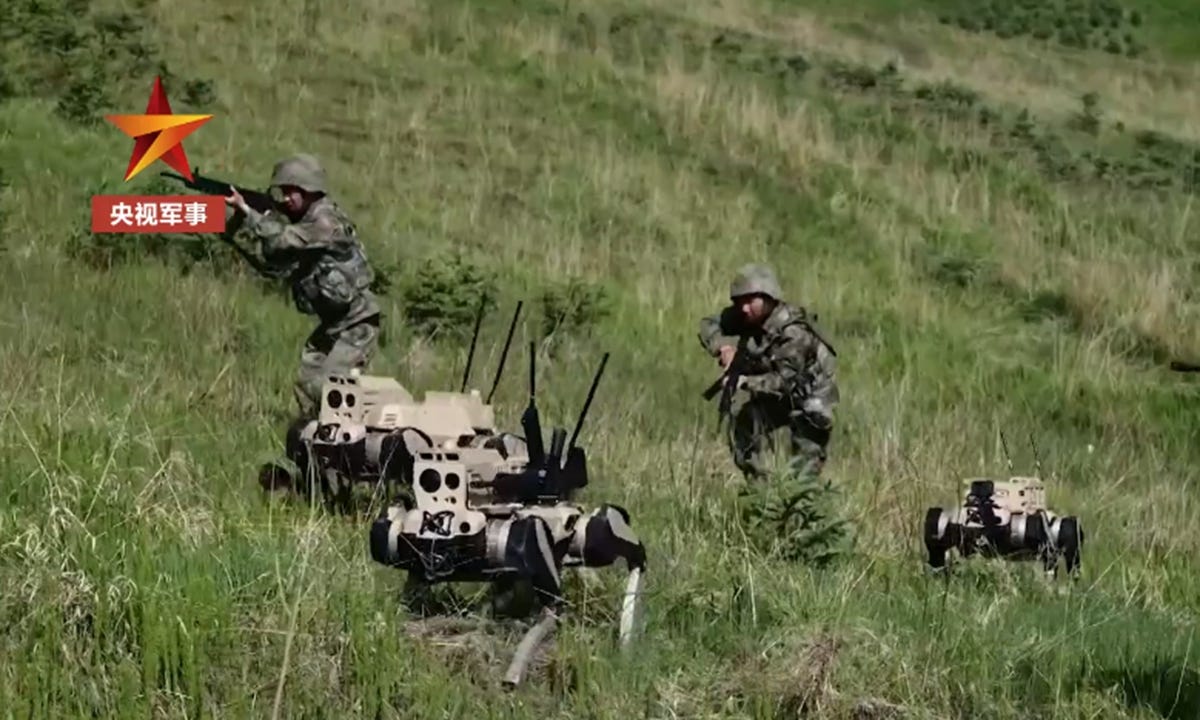
Strategic Strike Groups
The main demonstrations of the strategic strike groups, led by the PLA Rocket Force, focused on unveiling key pillars of China’s missile arsenal – the “Jinglei-1” air-launched long-range missile, the “Julang-3” submarine-launched intercontinental missile, the novel “Dongfeng-61” land-based intercontinental missile, and also the new “Dongfeng-31” land-based intercontinental missile. With these displays as part of the ‘First Missile Formation’, the goal was to present the land, air and sea troika of China’s missile shield and capabilities.
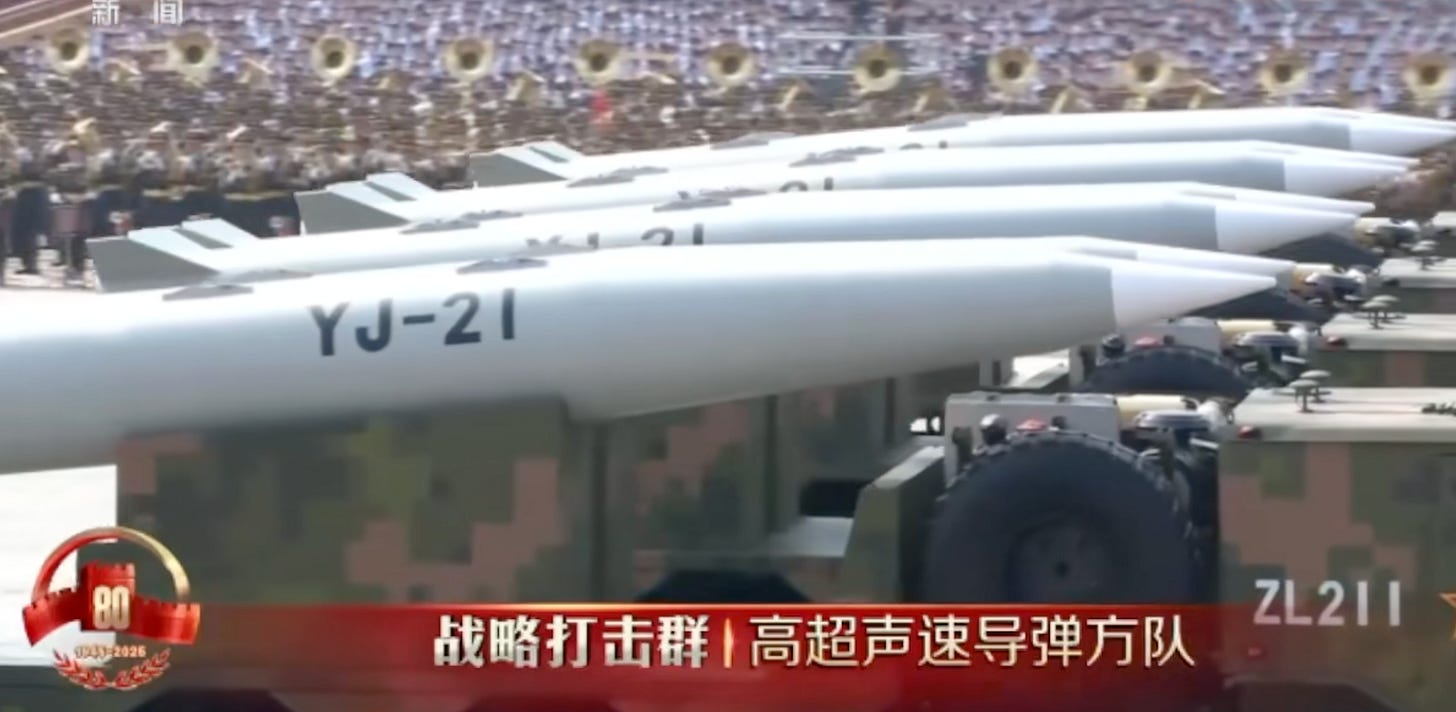
Further, there was the rather interesting display of the Second Nuclear Missile Formation, which showed 12 large missile transporter-erector-launchers (TEL)-carried “Dongfeng-5C” liquid-fueled intercontinental strategic nuclear missile in imposing formation. The Second Nuclear Missile Formation was the final formation of the equipment segment of the parade.
What’s fascinating is the evolution of the DFs (or ‘East Wind’ missiles), and the culmination the DF-5C displays (for now). DF-5 is one of the oldest ICBM’s in China’s arsenal, and it had its first flight in 1971. It was a liquid fuelled missile at that point as well, even though ever since, the new DFs (21, 31 and 41) have transitioned to solid fuel. Solid fuel is cheapter and takes lesser time to load and deploy, while liquid fuel takes much longer to load (preparation time for DF-5 in the 70s was between 30-60 minutes!) After the transition to solid-fuel missiles, it’s interesting to understand the reasoning behind having the liquid-fuelled DF-5C.
Expert coverage of this variant discusses novel features in the ICNM. For starters, the DF-5C introduces a new structural design, with the missile being divided into three sections, each transported separately by dedicated vehicles. This modular approach is expected to reduce launch preparation time compared to earlier DF-5 variants, enabling faster responsiveness. In terms of capability, the DF-5C has an extended range (potentially exceeding 20,000 kilometers), allowing it to strike anywhere across the globe. This is meant to ensure that China retains the ability to launch counterattacks against any military targets that present a nuclear threat. Another key feature is its flexibility in launch methods, and its flight speed is estimated to reach multiple tens of Mach, potentially leaving little opportunity for modern missile defence systems to intercept it. Additionally, the DF-5C is capable of carrying multiple independently targetable reentry vehicles (MIRVs), armed with either nuclear or conventional warheads. Finally, supported by China’s Beidou navigation system and a combination of advanced guidance technologies, the missile is expected to achieve a high degree of precision (unlike other ICBMs, DF-5C does not have starlight guidance with an inertial navigation system). It was also argued in the parade’s coverage that the 5C is supposed to be on “full alert” and provides effective deterrence, “using force to stop war and stabilize the world.” To whomever it concerns – prepare accordingly!
It remains to be seen how preparation time is cut, and what the actual range of the variant is. That said, the overall display of intercontinental missile capabilities, and the launch-on-warning threats, made for a fun read of the news on the parade.


